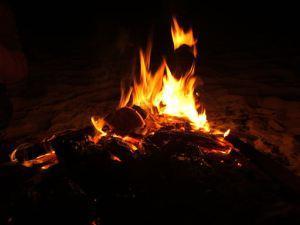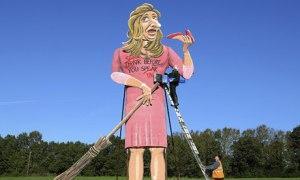 Remember, remember the fifth of November!
Remember, remember the fifth of November!
Gunpowder, treason and plot.
There is no reason that gunpowder treason
Should ever be forgot.
This short rhyme, often recited at this time of year, is part of a longer verse appearing in Notes and Queries in 1857. A similarversion, differing by a few lines, can be found in English Folk-rhymes: A Collection of Traditional Verses Relating to Places and Persons, Customs, Superstitions, Etc. (1892):
Remember, remember,
The Fifth of November
Gunpowder treason and plot:
For I see no reason
Why Gunpowder Treason
Should ever be forgot
Guy Fawkes, Guy, ’tis our intent.
To blow up the king and his parliament.
Threescore barrels, laid below,
To prove old England’s overthrow.
By God’s providence he got catched
With a dark lantern and burning match.
A stick and a stake
For King George’s sake!
And a rope and a cart
To hang Bonyparte!
Pope, Pope, Spanish Pope!
Nobody’s coming to town.
A halfpenny loaf to feed old Pope,
And a penn ‘orth of cheese to choke him;
A pint of beer to drink his health,
And a twopenny faggot to burn (qu. smoke) him;
Burn his body from his head,
And then we’ll say, “Old Pope is dead.”
Holla, boys, holla, make your voices ring!
Holla, boys, holla, God save the King!
Hip, hip, hoorr-r-r-ray!
‘Remember, Remember’ is one of the few rhymes around whose legend matches its origin; the events described in the additional stanzas really did happen.
We all know that the lines refer to the unsuccessful Gunpowder Plot of 1605, in which Catholic convert Guy Fawkes and the Wintour brothers, led by Robert Catesby, attempted to assassinate Protestant James I and his aristocracy by blowing up the House of Lords. Pages detailing the events of and leading up to the fifth of November 1605 are ten-a-penny online, but the Gunpowder Plot Wikipedia page is a reasonable place to start.

Guy Fawkes with his cronies
image from educationscotland.gov.uk
With the passing of the Observance of 5th November Act (1606), 5th November became an officially sanctioned annual day of commemoration, with mandatory church attendance and the lighting of bonfires in celebration of God’s “power and mercy in the miraculous and gracious deliverance of his [sic] church”. The act was repealed in 1859 but the tradition of lighting bonfires, burning effigies of Guy Fawkes or the Pope (which became widespread in the 1670s), and setting off fireworks each 5th November continues.
Up and to the office, where all the morning, at noon to the ‘Change, and thence home to dinner, and so with my wife to the Duke’s house to a play, “Macbeth,” a pretty good play, but admirably acted. Thence home; the coach being forced to go round by London Wall home, because of the bonefires; the day being mightily observed in the City. To my office late at business, and then home to supper, and to bed.
Pepys diary, 5th November 1664
Everywhere bangs and happy shouts of children. It’ the first big Bonfire Night since war started, bringing back faint echoes of our jolly parties, and the last one, so wild and gay, when Arthur had got word he had won his Inspectorate exam [...]. It was a cheap party, sausage and mash, but so many rolled up with the 6d of fireworks they has agreed and of course Jack Gorst’ contribution was nearer to £6 than 6d! Of that happy ‘ignorant’ crowd, eight didn’t come back, one has queer nerve lapses and two of the girls were left widows.
Nella Last’s diary, 5th November 1947
Despite what some rabble-rousing tabloids wielding dodgy statistics would have us believe, the sectarian origins of what has come to be known as Bonfire night have largely been discarded, and today it is common to see effigies of unpopular or disgraced media personalities burned in place of the traditional Guy.

An effigy of Katie Hopkins, ex-Apprentice contestant and drivel-mouthed, bourgeois idiot, is prepared for burning in Edenbridge, November 2013.
image from http://www.Guardian.com
With so many histories concentrating on the story behind the rhyme, it is difficult to trace the history of the words themselves – especially when you’ve lost your access to academic journals, as I have – but Iona and Peter Opie, in The Lore and Language of School Children, note that it is first recorded in 1792 in An Agreeable Companion:
Don’t you Remember,
The Fifth of November,
‘Twas Gunpowder Treason Day,
I let off my gun,
And made’em all run.
And Stole all their Bonfire away.
Though the lyric is markedly different, the meter and rhyme scheme and rhythm of the verse is very similar to the version we know today. Rather than reminding us to commemorate the date, the rhyme urges mischief, a trend which continues in similar verses like this version, from Halliwell (1842):
Don’t you know ‘tis the fifth of November,
Gunpowder Plot. Were come to beg
A stick or a stake, for King Geoge’s sake
If you won’t give us one well take two
Then ricket a racket your door shall go.
this dialect poem, from Berkshire in the 1890s, reprinted in Ronald Hutton’s Stations of the Sun: A History of the Ritual Year in Britain:
Remember, remember, the Vifth of November,
Gunpowder, trason and plot,
Pray tell me the reason why Gunpowder trason,
Should iver be vorgot.
Our Quane’s a valiant Zawlger,
Car’s her blunderbus on her right shawlder,
Cocks her pitol, drays her rapier,
Praay gie us zummit vor her zaayke yer,
A stick, an’ a styaake vor Quane Vickey’s zaakye,
If’e wunt gie on I’ll taayke two,
The better for we an’ the wus vor you.
The exuberant devilry expressed in the rhymes describes a real behavior – the theft of broomsticks out of which to construct an effigy was a common problem for Victorian householdsin North Yorkshire - and impish pranks and riotous cavorting through the streets became so associated with the day before fifth November that it has in the UK usurped Mayday as Mischief Night, with the ex post facto explanation that this the night the Gunpowder plotters made final their plans. Most of the rhymes describe fairly harmless activites associated with Bonfire Night like begging for kindling, food and pennies, but some are darker, and reveal the religious animosity at the heart of the Gunpowder Plot, like this straightforward anti-Catholic doggerel local to Exeter:
Please to remember the Fifth of November
Up with the ladder, down with the rope,
Please give us a penny to burn the old pope.
There are countless version of ‘Remember, Remember…’, many of which are collected on this website. That so many versions begin with the same November/remember rhyme is curious, though it is as likely to be down to the simplicity of the rhyme as anything else. Why the lines at the top of this post have entered into common consciousness where the variants have not is a question no one can really answer. Perhaps the words the longer variants never escaped their regional borders, perhaps the rhythm and rhyme of of ‘Remember, Remember…’ simply make it easier to recall.
It’s impossible to know who first spoke the word that have become so familiar to us, or who first wrote them down. We can, however deduce that the rhyme has maintained its popularity through the centuries because of how often the refrain is borrowed. From a poem performed at a celebration in 1760s Massachusets to the 2006 film adaptation of Alan Moore and David Lloyd’s V for Vendetta, the words have found their way into popular culture, where they will certainly remain.
